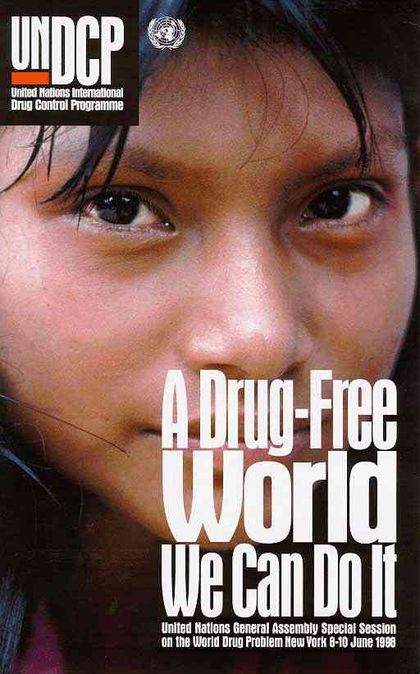The killer fact is a public speaker's friend. It can be used as a way of not so much simplifying a complex argument, but of giving the audience a peg on which to anchor the complexity. I deployed a few of them in my talk introducing the drug policy discussion at Splore on Saturday, but none of them stirred as audible a response from the crowd as this part:
At UNGASS 1998 – the second meeting of the United Nations' most senior policy-making body, the General Assembly, to discuss the global drug problem – the boundlessly confident slogan for the event was: "A drug-free world – we can do it!"
The slogan was the key line in a UN-funded promotional video, screened as a paid ad on television, featuring helicopters spraying herbicides, fields of burning drug crops, armed soldiers and a farmer processing coffee. The message was clear: the community of nations was turning the big guns on the drug trade and woe betide anyone who got in the way. It was the war on drugs made literal.
Pino Arlacchi, Executive Director of the UN Drug Control Program, even put a deadline on it, writing a special article for the UN Chronicle under the headline ‘Towards a Drug-Free World by 2008 – We Can Do It’.
Needless to say, the world was not drug-free by 2008. Indeed, it appeared that a programme that had begun with the first UNGASS on drugs in 1991 (which heralded the "United Nations Decade Against Drug Abuse", 1991-2000) was, if anything, making the harms of the illicit drug trade even worse.
In 2014, I wrote an article on the drug trade and economic development, which quoted our Splore guest, Sanho Tree of the Institute of Policy Studies, on the unintended consequences of the crop destruction programme that followed UNGASS 1988:
Another problem with forced eradication, says Tree, is that it may cause farmers to adapt with unpredictable consequences. After visible coca crops in Colombia were repeatedly wiped out by US spray planes in the early 2000s, “farmers began to intercrop and shade-grown varieties of coca were introduced, along with new processing and extraction techniques with high yields. The varieties they were replanting with were more productive than the old ones – varieties that were suited to cocaine production rather than chewing.
Far from Latin America's drug war, in the nightclubs of the western world, the UN did succeed in sharply limiting the availability of the ubiquitous dance party drug MDMA, by clamping down on the supply of a key precursor, safrole. This, too, had unintended consequences: it ushered in the era of substitute party drugs – all of them less well-understood and most of them more dangerous than MDMA. The situation only stablised when a German chemist devised a way of synthesising MDMA without safrole a couple of years ago.
So it's not entirely surprising that by 2008, the UN was trying to forget the "drug free world" was ever a goal.
The Director of UNDCP’s successor, the UN Office on Drugs and Crime (UNODC), Antonio Maria Da Costa, insisted to the makers of the Irish documentary War Without End that, "I would like to remind you that the United Nations never used the word ‘a drug-free world’. In no official documents of the United Nations you will find reference to ‘a drug-free world’."
This link jumps directly to that part of the documentary.
“At the UN today,” intones the documentary’s voiceover, “the ‘drug-free world’ slogan of 1998 appears something of an embarrassment.”
This history and the prospects for the third drugs UNGASS, which takes place in April in New York, are covered in a feature I wrote for Matters of Substance, the magazine of the New Zealand Drug Foundation.
In theory, things should be very different this time. UNGASS itself has been brought forward two years at the request of the presidents of Colombia, Mexico and Guatemala. Latin American countries as a group – always uneasy about the big-guns approach to supply reduction – also made a joint call to review the current system and “analyse all available options, including regulatory or market measures”.
A string of UN agencies, including the UN Development Program under Helen Clark and even UNODC itself – in a controversially withdrawn paper – have called for change and a move toward decriminalisation.
Kofi Annan, who presided in 1998 as UN Secretary General, has turned 180 degrees and wrote in an essay just published by Der Spiegel that "we need to accept that a drug-free world is an illusion" and that this year's UNGASS "would be a good place to start" on first the decriminalisation of drugs and then their legalisation and regulation.
Even the United States, for half a century the self-appointed policeman of the UN drug treaties, is now allowing one state after another to establish regulated, legal markets in marijuana.
And yet, the world is highly unlikely to change in April. The dread words "harm reduction" may finally find their way into an official declaration, although that's far from certain. The US may finally stop seeking common cause with Saudi Arabia, Russia and China on drug control issues. But it'll be baby steps, all bound by the requirement for consensus among participating nations.
For more detail, you can read my feature, which is quite lengthy and includes comments from Peter Dunne on the position New Zealand will take into UNGASS. (TL-DR: We will again go in as one of the liberal, reformist nations, our own terrible domestic contradictions notwithstanding.)
You can also listen to Sanho's interview with Kathryn Ryan today.
And you can tune in to Story on TV3 at 7pm tomorrow evening for Kim Vinnell's report on the Splore talk – which features Sanho, the very sensible harm reduction advocate Wendy Allison and me, possibly being a bit ranty.
